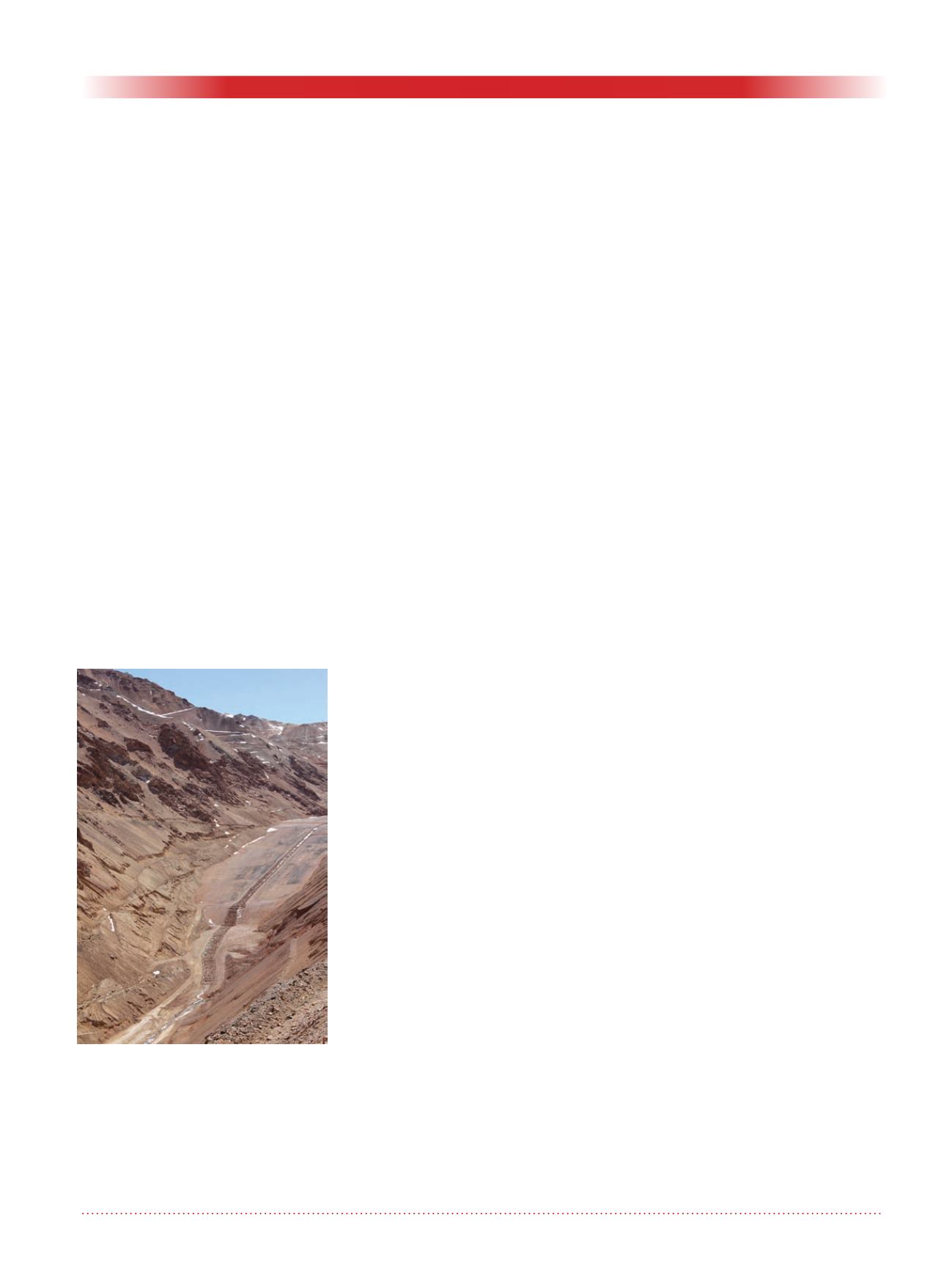
Geotechnical News • March 2015
45
WASTE GEOTECHNICS
in the accumulation of some 300
million tons of tailings, creating an
immense beach deposit along the
coast. While active deposition of tail-
ings ended decades ago, and various
remediation projects have come and
gone, square kilometers of exposed
tailings remain, and one can easily
see the accumulation of tailings dust
throughout the community of Cha-
ñaral to the south. Traveling across
the tailings on the public road, even
on mildly windy days blowing tailings
reduce visibility.
Given the vast cumulative extent of
tailings deposits in the country, dust
control is not a trivial matter. The typi-
cal methodology proposed for closure
is the placement of a granular cover.
However, taking the example of one
of the larger deposits in the country
which at closure will cover roughly
6000 hectares, a 15 cm cover would
translate into a need for over 9 million
cubic meters of fill material – a signifi-
cant mine in its own right if obtained
from a borrow source, and with practi-
cally any source of cover material, a
significant closure cost.
Alternatives to granular covers
abound. Anecdotal evidence and
laboratory work conducted by Golder
Associates suggests that when waters
with high salt content are used to
transport the tailings (either seawater
or desalinated seawater – both increas-
ingly being evaluated for mining
use), subsequent drying of the tailings
results in the formation of a resistant
salt crust on the tailings, that effec-
tively eliminate dust generation. Some
researchers have shown the benefits
of windrows on the tailings surface
to reduce wind erosion, with a lower
material cost than a complete cover.
But with the example of Chañaral
never far from the mind, solid stud-
ies will be needed to convince the
authorities that such alternatives, as
yet undemonstrated in Chile, will meet
long term needs.
Closures to date
Few sites have been closed in Chile.
The closure of the coal mine at Lota in
the south in 1997 continues to resonate
as a cautionary tale, not for technical
challenges, but for the dramatic com-
munity impacts that resulted from the
closure. Even 10 years after closure,
the community was marked by high
levels of poverty, unemployment, and
demonstrations by the ex-miners.
A much more positive example is
the locally owned Lo Aguirre site,
located just west of Santiago. In 2000,
the site presented a voluntary closure
plan, which was largely implemented
by 2008. Lacking the resources of
international mining companies, the
closure works were resourcefully self-
financed, largely through the sale of
scrap generated in closure activities,
and sale of copper obtained through
reprocessing of select wastes. Social
impacts were virtually non-existent,
thanks to the proximity of the mine to
the larger, diversified economy, and
closure in a time of high economic
growth.
Perhaps the most emblematic closure
to date has been the El Indio site (see
Photo 3), located at over 4000 meters
above sea level in the arid Andes,
close to the border with Argentina.
When mining operations terminated in
2002, the owner of the site (Barrick)
implemented a closure program that
was nationally unprecedented. In the
absence of clear closure regulations at
the time, Barrick undertook a volun-
tary agreement with the authorities,
presenting a complete and detailed
closure plan, developed in accordance
with current international practices.
Application of this plan resulted in
completion of the majority of closure
works in 2005, prior to the obligation
to present any sort of closure plan
under the first closure law. Workers
relocated rapidly thanks to the high
national demand for mining experi-
ence at the time of closure.
Closure in the future
The coming years promise to rede-
fine mine closure in Chile. Large,
aging mines that are nearing closure,
relatively little practical experience
with mine closure at a national level,
and a new legal framework create
both uncertainty and considerable
opportunity. While the new closure
law is arguably flawed, it represents
an important leap forward. The timely
imposition of financial guarantees for
closure should go a long way towards
the stated goal of avoiding abandoned
mine sites in the future, and motivate
serious consideration and study of
adequate closure measures earlier in
the mine life cycle.
Björn Weeks
Golder Associates
200, 2920 Virtual Way
Vancouver, BC,V5M 4X3
T: 604-296-4200, F: 604-298-5253
email:
Photo 3. The closed and covered
tailings at El Indio, Barrick’s pioneer-
ing work that set the national refer-
ence point for mine closure practice
in Chile. Photo shows the closed
and covered tailings deposit in the
valley, with channel restoration
along the axis of the deposit.


